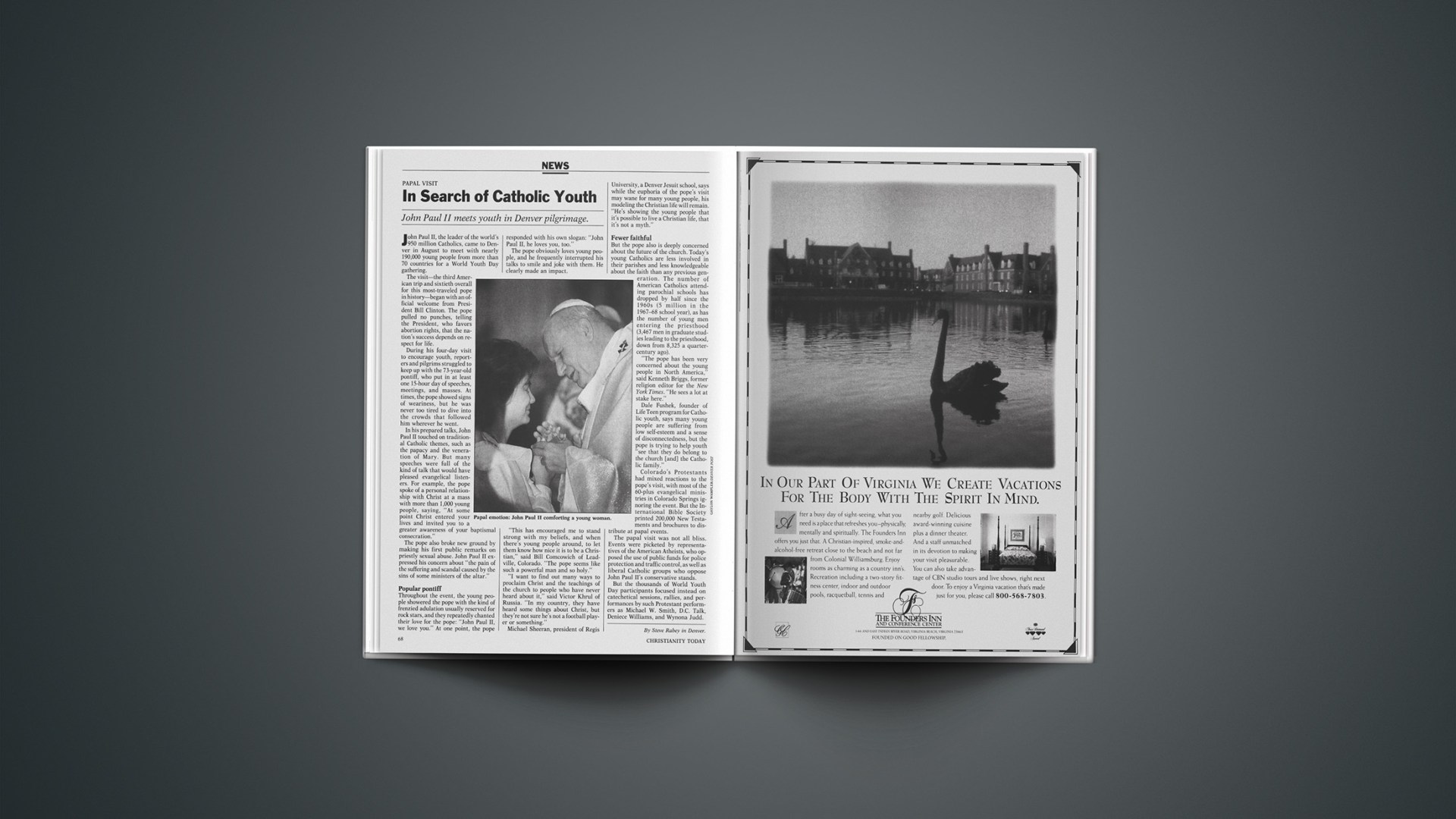John Paul II meets youth in Denver pilgrimage.
John Paul II, the leader of the world’s 950 million Catholics, came to Denver in August to meet with nearly 190,000 young people from more than 70 countries for a World Youth Day gathering.
The visit—the third American trip and sixtieth overall for this most-traveled pope in history—began with an official welcome from President Bill Clinton. The pope pulled no punches, telling the President, who favors abortion rights, that the nation’s success depends on respect for life.
During his four-day visit to encourage youth, reporters and pilgrims struggled to keep up with the 73-year-old pontiff, who put in at least one 15-hour day of speeches, meetings, and masses. At times, the pope showed signs of weariness, but he was never too tired to dive into the crowds that followed him wherever he went.
In his prepared talks, John Paul II touched on traditional Catholic themes, such as the papacy and the veneration of Mary. But many speeches were full of the kind of talk that would have pleased evangelical listeners. For example, the pope spoke of a personal relationship with Christ at a mass with more than 1,000 young people, saying, “At some point Christ entered your lives and invited you to a greater awareness of your baptismal consecration.”
The pope also broke new ground by making his first public remarks on priestly sexual abuse. John Paul II expressed his concern about “the pain of the suffering and scandal caused by the sins of some ministers of the altar.”
Popular pontiff
Throughout the event, the young people showered the pope with the kind of frenzied adulation usually reserved for rock stars, and they repeatedly chanted their love for the pope: “John Paul II, we love you.” At one point, the pope responded with his own slogan: “John Paul II, he loves you, too.”
The pope obviously loves young people, and he frequently interrupted his talks to smile and joke with them. He clearly made an impact.
“This has encouraged me to stand strong with my beliefs, and when there’s young people around, to let them know how nice it is to be a Christian,” said Bill Comcowich of Leadville, Colorado. “The pope seems like such a powerful man and so holy.”
“I want to find out many ways to proclaim Christ and the teachings of the church to people who have never heard about it,” said Victor Khrul of Russia. “In my country, they have heard some things about Christ, but they’re not sure he’s not a football player or something.”
Michael Sheeran, president of Regis University, a Denver Jesuit school, says while the euphoria of the pope’s visit may wane for many young people, his modeling the Christian life will remain. “He’s showing the young people that it’s possible to live a Christian life, that it’s not a myth.”
Fewer faithful
But the pope also is deeply concerned about the future of the church. Today’s young Catholics are less involved in their parishes and less knowledgeable about the faith than any previous generation. The number of American Catholics attending parochial schools has dropped by half since the 1960s (5 million in the 1967–68 school year), as has the number of young men entering the priesthood (3,467 men in graduate studies leading to the priesthood, down from 8,325 a quarter-century ago).
“The pope has been very concerned about the young people in North America,” said Kenneth Briggs, former religion editor for the New York Times. “He sees a lot at stake here.”
Dale Fushek, founder of Life Teen program for Catholic youth, says many young people are suffering from low self-esteem and a sense of disconnectedness, but the pope is trying to help youth “see that they do belong to the church [and] the Catholic family.”
Colorado’s Protestants had mixed reactions to the pope’s visit, with most of the 60-plus evangelical ministries in Colorado Springs ignoring the event. But the International Bible Society printed 200,000 New Testaments and brochures to distribute at papal events.
The papal visit was not all bliss. Events were picketed by representatives of the American Atheists, who opposed the use of public funds for police protection and traffic control, as well as liberal Catholic groups who oppose John Paul II’s conservative stands.
But the thousands of World Youth Day participants focused instead on catechetical sessions, rallies, and performances by such Protestant performers as Michael W. Smith, D.C. Talk, Deniece Williams, and Wynona Judd.
By Steve Rabey in Denver.










